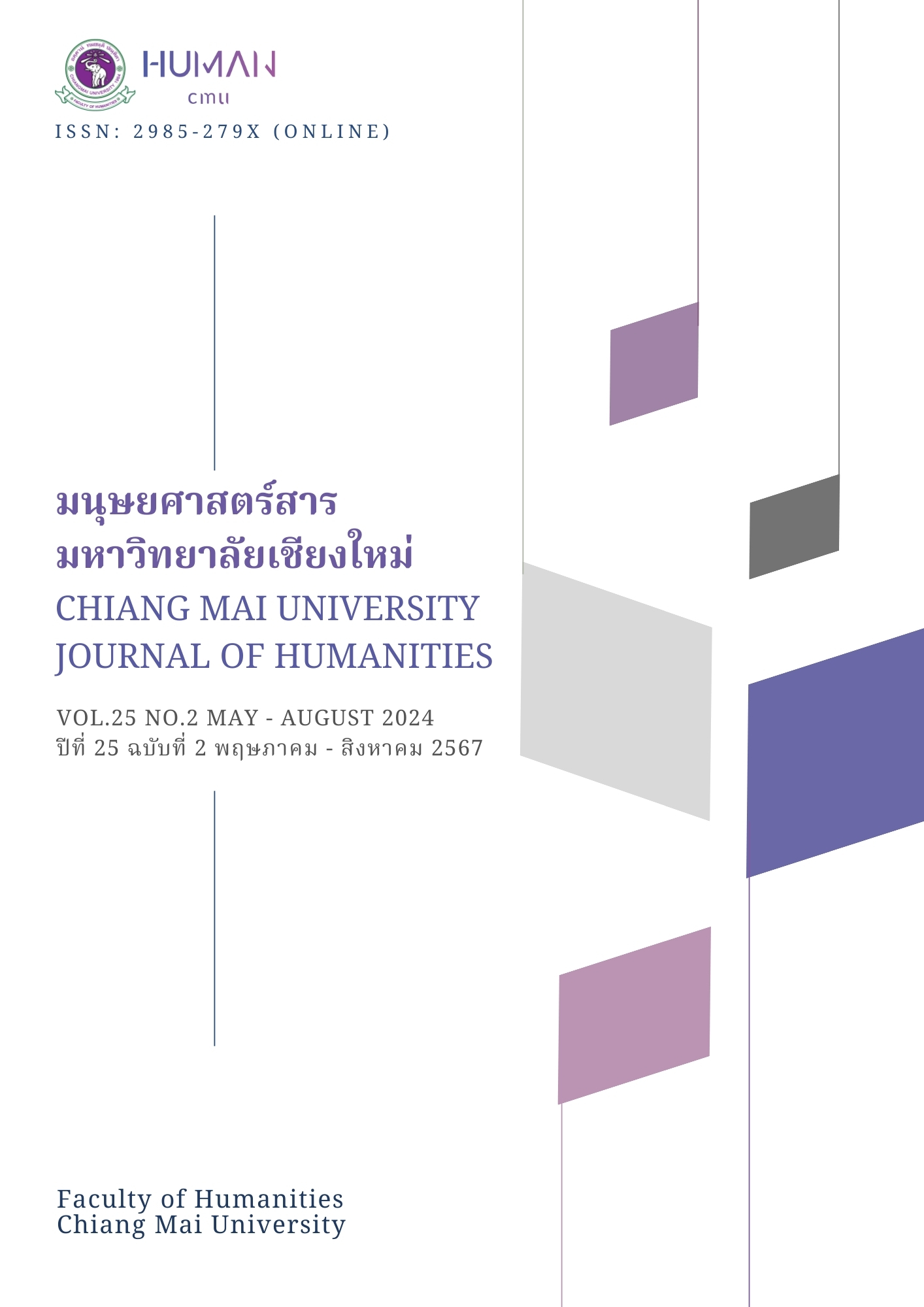โลกของความสะอาด: แม่บ้านพ่อบ้านไทใหญ่จ้างเหมาบริการในเชียงใหม่
Main Article Content
บทคัดย่อ
โลกของความสะอาดคือกรอบแนวคิดที่บทความวิจัยนี้นำมาแสดงให้เห็นถึงความสัมพันธ์ระหว่างการจ้างงานแบบเหมาช่วง แรงงานทำความสะอาดไทใหญ่ และปฏิสัมพันธ์เชิงผัสสะในงานบริการด้านความสะอาด ผู้เขียนใช้การศึกษาสังคมจุลภาคและการศึกษาชาติพันธุ์วรรณาเชิงสถาบันเป็นวิธีวิทยาในการเก็บรวบรวมข้อมูลภาคสนามเกี่ยวกับสภาพการทำงานและเงื่อนไขชีวิตของแรงงานภายใต้ระบบธุรกิจบริการทำความสะอาดเชิงพาณิชย์ในพื้นที่ชุมชนสถานศึกษา โดยทบทวนแนวคิดว่าด้วยความสะอาดอันเป็นกลไกการจำแนกแยกแยะอัตภาวะและความสัมพันธ์ทางสังคม ตลอดจนพัฒนาการแห่งยุคสมัยที่ก่อให้เกิดมาตรฐานและผัสสารมณ์แห่งความสะอาดผ่านการจ้างงานแม่บ้านพ่อบ้านเช่นในปัจจุบัน ผัสสารมณ์ใต้เพดานความสะอาดที่เกิดขึ้นนี้ได้กลายเป็นตัวกำหนดคุณค่าและมูลค่าของแรงงานทำความสะอาด โดยเฉพาะกระบวนการจัดการร่างกายที่ดูไม่สะอาด สิ่งที่ดูไม่เข้าที่เข้าทางในพื้นที่และเวลาด้วยระเบียบของรัฐและทุน บทความวิจัยนี้ได้ชี้ให้เห็นผ่านการอภิปรายความสะอาดตามตารางพื้นที่และเวลาว่าการจ้างงานแบบยืดหยุ่นได้แยกส่วนแรงงานไทใหญ่ออกจากพื้นที่และเวลาซึ่งส่งผลโดยตรงต่อการมองเห็นคุณค่าของแรงงานทำความสะอาดน้อยกว่ามูลค่างบประมาณด้านความสะอาดตามระบบ
Article Details

อนุญาตภายใต้เงื่อนไข Creative Commons Attribution-NonCommercial-NoDerivatives 4.0 International License.
เอกสารอ้างอิง
กรมการจัดหางาน. (2544). การจัดประเภทมาตรฐานอาชีพ (ประเทศไทย) ฉบับปี 2544.
https://www.nstda.or.th/home/knowledge_post/tsco/
กรมการจัดหางาน. (2566). สถิติจำนวนต่างด้าวที่ได้รับอนุญาตทำงานคงเหลือทั่วราชอาณาจักร ฉบับประจำเดือน
มีนาคม 2566.
https://www.doe.go.th/prd/assets/upload/files/alien_th/e82ce3112167e110bbb14884af4df848.pdf
กรมพัฒนาธุรกิจการค้า. (2563). บทวิเคราะห์ธุรกิจ: ธุรกิจน่าจับตามอง ปี 2563.
https://www.dbd.go.th/download/document_file/Statisic/2563/T26/T26_202008.pdf
กฤษฏิญา ไชยศรี. (2565, 15 เมษายน). Abject Art ศิลปะแห่งความโสโครก อาตม และความน่ารังเกียจ.
GroundContril. https://groundcontrolth.com/blogs/art-term-abject-art
จิตตวดี จิตรพงศ์. (2556). ความสะอาดของพระนคร: การเมืองเรื่องวิถีปลงศพในสมัยรัชกาลที่ห้า. หน้าจั่ว, 10:
-101.
ทีมข่าว TCIJ. (2561, มิถุนายน 17). หวั่นอาชีพ ‘แม่บ้านผ่านแอปฯ’ กฎหมายแรงงานไม่คุ้มครอง ตีความยาก
‘ลูกจ้าง-นายจ้าง’. ศูนย์ข้อมูลและข่าวสืบสวนเพื่อสิทธิพลเมือง. https://www.tcijthai.com/news/2018/17/scoop/8072
ภิญญพันธุ์ พจนะลาวัณย์. (2560). สถานะที่มองไม่เห็นของแม่บ้านและภารโรงในพื้นที่ทำงาน กรณีศึกษา
สถาบันอุดมศึกษา. วารสารสังคมศาสตร์ มหาวิทยาลัยนเรศวร, 13(1), 7-25.
ยุกติ มุกดาวิจิตร. (2541). พิธีกรรมของกลิ่นกาย. ใน ปริตตา เฉลิมเผ่า กออนันตกูล (บ.ก.), เผยร่าง-พรางกาย:
ทดลองมองร่างกายในศาสนา ปรัชญาการเมือง ประวัติศาสตร์ ศิลปะ และมานุษยวิทยา (น.235-260). โครงการจัดพิมพ์คบไฟ.
ศรยุทธ เอี่ยมเอื้อยุทธ. (2563). การเดินทางในระยะห่างของดวงตา. สำนักพิมพ์ระหว่างบรรทัด.
ศรัญญา ใจอินต๊ะ. (2558). สภาพการทำงานของพนักงานรักษาความสะอาดที่เป็นแรงงานต่างถิ่นใน
มหาวิทยาลัยเชียงใหม่. [ศิลปศาสตรมหาบัณฑิต (เศรษฐศาสตร์การเมือง), มหาวิทยาลัยเชียงใหม่].
Chiang Mai University Digital Collection. https://cmudc.library.cmu.ac.th/frontend/Creator/personDc/88234
สำนักงานแรงงานจังหวัดเชียงใหม่. (2564, สิงหาคม 10). สถานการณ์แรงงานจังหวัดเชียงใหม่ ไตรมาส 2/2564.
https://chiangmai.mol.go.th/wp-content/uploads/sites/18/2021/08/site-mol-2.jpg
ออมสิน บุญเลิศ. (2552). วาทกรรมว่าด้วย “คนต่างด้าว” กับการกลายเป็น “คนอื่น” ของชาวไทใหญ่พลัดถิ่น.
วารสารสังคมศาสตร์ มหาวิทยาลัยเชียงใหม่, 21(2), 103-141.
อานันท์ กาญจนพันธุ์ และ ชัยพงษ์ สำเนียง. (2557). แรงงานข้ามชาติ: อัตลักษณ์และสิทธิความเป็นพลเมือง.
สถาบันศึกษานโยบายสาธารณะ มหาวิทยาลัยเชียงใหม่.
Amato, J. (1996). Review Chasing dirt: The American pursuit of cleanliness by Suellen Hoy.
Journal of Social History, 30(1), 277-282. https://www.jstor.org/stable/3789770
Bataille, G. L'Abjection et les formes misérables [Abjection and miserable forms]. In S. Lotringer
(Ed.), More and less. MIT Press.
Brines, J. (1994). Economic dependency, gender, and the division of labor at home. Am. J. So-
ciol, 100, 652–88
Campkin, B., & Cox, R. (2007). Introduction: Materialities and metaphors of dirt and Cleanliness.
In B. Campkin & R. Cox (Eds.), Dirt: New geographies of cleanliness and contamination (pp.1-10). I.B. Tauris.
Dant, T., & Bowles, D. (2003). Dealing with dirt: Servicing and repairing cars. Sociological Research
Online, 8(2). https://doi.org/10.5153/sro.793
Dimpfl, M. (2016). Clean U: Cleanliness, Social Difference, and the Dirty Work of Everyday
Hygiene. [Doctoral dissertation, The University of North Carolina Chapel]. Carolina Digital Repository. https://cdr.lib.unc.edu/concern/dissertations/rb68xc06r?locale=en
Dimpfl, M. (2018). Micro(bial) management: Everyday cleanliness and the divisive power of
hygienic worries. Cultural Geographies, 25(1), 201-216. https://www.jstor.org/stable/26402629
Douglas, M. (1966). Purity and Danger: An Analysis of Concepts of Pollution and Taboo.
Routledge and Kegan Paul.
Dowdeswell, M. (2022, November 7). Hygiene through history: How filthy were our ancient
ancestors? Ancient origins: Reconstructing the story of humanity’s past. https://www.ancient-origins.net/history-ancient-traditions/hygiene-0017494
Fine, G. A., & Hallett, T. (2003). Dust: A study in sociological miniaturism. The Sociological
Quarterly, 44(1), 1-15. https://www.jstor.org/stable/4120755
Flecker, J. (2010). Fragmenting labour: Organisational restructuring, employment relations and
the dynamics of national regulatory frameworks. Work Organisation, Labour & Globalisation, 4(1), 8-23. https://doi.org/10.13169/workorgalaboglob.4.1.0008
Freud, S. (1919). Das unheimliche [The “uncanny”].
https://web.mit.edu/allanmc/www/freud1.pdf
Gill, N.S. (2019, August 2). Roman baths and hygiene in ancient Rome. ThoughtCo.
https://www.thoughtco.com/hygiene-in-ancient-rome-and-baths-119136
Hardt, M. (1999). Affective Labor. Boundary2, 26(2), 89-100.
Hill, B. (2022, May 8). Ancient Romans brushed their teeth with urine. Ancient origins:
Reconstructing the story of humanity’s past.
https://www.ancient-origins.net/weird-facts/roman-urine-0016738
Hochschild, A. R. (2012). Managed heart: Commercialization of human feeling. University of
California Press.
Horsfield, M. (1998). Biting the dust: The joys of housework. Picador.
Hoy, S. (1995). Chasing dirt: The American pursuit of cleanliness. Oxford University Press.
Kristeva, J. (1982a). Pouvoirs de l'horreur. Essai sur l'abjection [Powers of horror: An essay on
abjection]. Columbia University Press.
Kristeva, J. (1982b). Approaching abjection. Oxford Literary Review, 5(1/2), 125-149.
https://www.jstor.org/stable/43973647
Lai, L. (2016). Hygiene, sociality, and culture in contemporary rural China. Amsterdam University
Press.
Mansfield, N. (2000). Subjectivity: Theories of the self from Freud to Haraway. New York
University Press.
Mark, J. J. (2021, July 14). The fullers of ancient Rome. World History Encyclopedia.
https://www.worldhistory.org/article/46/the-fullers-of-ancient-rome/
Martens, L. (2007). The visible and the invisible: (De)regulation in contemporary cleaning
practices. In B. Campkin & R. Cox (Eds.), Dirt: New geographies of cleanliness and contamination (pp.34-48). I.B. Tauris.
Ollus, N. (2016). Forced flexibility and exploitation: Experiences of migrant workers in the
cleaning industry. Nordic Journal of Working Life Studies, 6(1), 25-45.
DOI: 10.19154/njwls.v6i1.4908
Pink, S. (2012). Situating everyday life: Practices and places. Sage.
Robinson, O. F. (1992). Ancient Rome: City planning and administration. Routledge.
Smith, D. E. (2003). Making sense of what people do: A sociological perspective. Journal of
Occupational Science, 10(1), 61-64. DOI: 10.1080/14427591.2003.9686512
Smith, D. E. (2005). Institutional ethnography. In M. Xenitidou & N. Gilbert (Eds.), Innovations in
social science research methods (pp.32-33). University of Surrey.
Stolte J. F., Fine G. A., & Cook K. S. (2001). Sociological miniaturism: Seeing the big through the
small in social psychology. Annual Review Sociology, 27, 387-413.
Wyatt, I. D., & Hecker, D. (2006). Occupational changes during the 20th century. Monthly Labor


